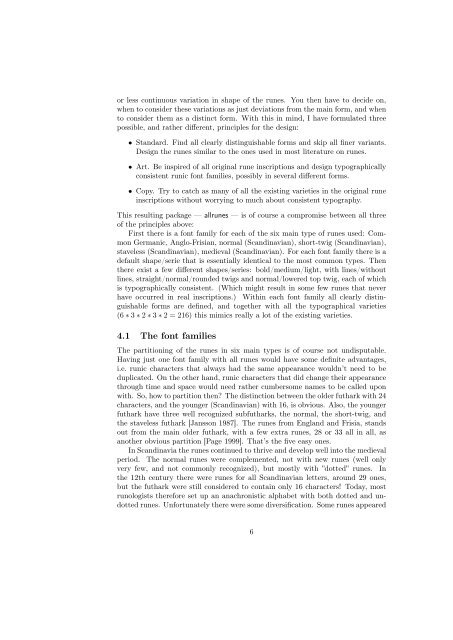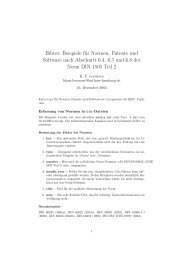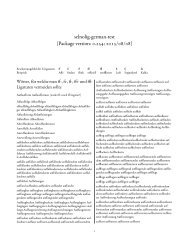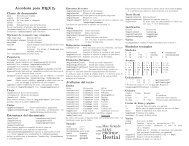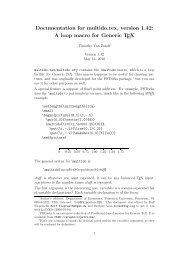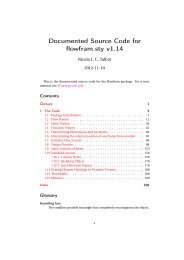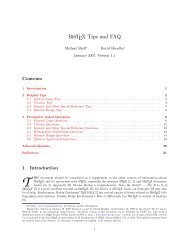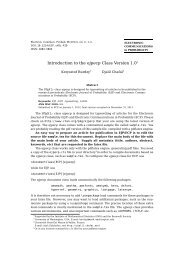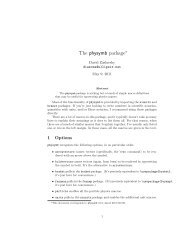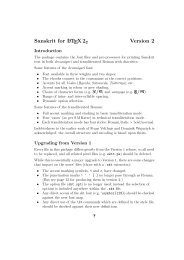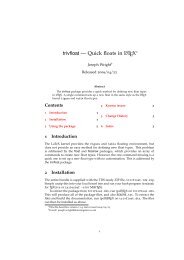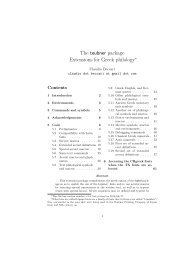The allrunes Font and Package. - CTAN
The allrunes Font and Package. - CTAN
The allrunes Font and Package. - CTAN
You also want an ePaper? Increase the reach of your titles
YUMPU automatically turns print PDFs into web optimized ePapers that Google loves.
or less continuous variation in shape of the runes. You then have to decide on,<br />
when to consider these variations as just deviations from the main form, <strong>and</strong> when<br />
to consider them as a distinct form. With this in mind, I have formulated three<br />
possible, <strong>and</strong> rather different, principles for the design:<br />
• St<strong>and</strong>ard. Find all clearly distinguishable forms <strong>and</strong> skip all finer variants.<br />
Design the runes similar to the ones used in most literature on runes.<br />
• Art. Be inspired of all original rune inscriptions <strong>and</strong> design typographically<br />
consistent runic font families, possibly in several different forms.<br />
• Copy. Try to catch as many of all the existing varieties in the original rune<br />
inscriptions without worrying to much about consistent typography.<br />
This resulting package — <strong>allrunes</strong> — is of course a compromise between all three<br />
of the principles above:<br />
First there is a font family for each of the six main type of runes used: Common<br />
Germanic, Anglo-Frisian, normal (Sc<strong>and</strong>inavian), short-twig (Sc<strong>and</strong>inavian),<br />
staveless (Sc<strong>and</strong>inavian), medieval (Sc<strong>and</strong>inavian). For each font family there is a<br />
default shape/serie that is essentially identical to the most common types. <strong>The</strong>n<br />
there exist a few different shapes/series: bold/medium/light, with lines/without<br />
lines, straight/normal/rounded twigs <strong>and</strong> normal/lowered top twig, each of which<br />
is typographically consistent. (Which might result in some few runes that never<br />
have occurred in real inscriptions.) Within each font family all clearly distinguishable<br />
forms are defined, <strong>and</strong> together with all the typographical varieties<br />
(6 ∗ 3 ∗ 2 ∗ 3 ∗ 2 = 216) this mimics really a lot of the existing varieties.<br />
4.1 <strong>The</strong> font families<br />
<strong>The</strong> partitioning of the runes in six main types is of course not undisputable.<br />
Having just one font family with all runes would have some definite advantages,<br />
i.e. runic characters that always had the same appearance wouldn’t need to be<br />
duplicated. On the other h<strong>and</strong>, runic characters that did change their appearance<br />
through time <strong>and</strong> space would need rather cumbersome names to be called upon<br />
with. So, how to partition then? <strong>The</strong> distinction between the older futhark with 24<br />
characters, <strong>and</strong> the younger (Sc<strong>and</strong>inavian) with 16, is obvious. Also, the younger<br />
futhark have three well recognized subfutharks, the normal, the short-twig, <strong>and</strong><br />
the staveless futhark [Jansson 1987]. <strong>The</strong> runes from Engl<strong>and</strong> <strong>and</strong> Frisia, st<strong>and</strong>s<br />
out from the main older futhark, with a few extra runes, 28 or 33 all in all, as<br />
another obvious partition [Page 1999]. That’s the five easy ones.<br />
In Sc<strong>and</strong>inavia the runes continued to thrive <strong>and</strong> develop well into the medieval<br />
period. <strong>The</strong> normal runes were complemented, not with new runes (well only<br />
very few, <strong>and</strong> not commonly recognized), but mostly with ”dotted” runes. In<br />
the 12th century there were runes for all Sc<strong>and</strong>inavian letters, around 29 ones,<br />
but the futhark were still considered to contain only 16 characters! Today, most<br />
runologists therefore set up an anachronistic alphabet with both dotted <strong>and</strong> undotted<br />
runes. Unfortunately there were some diversification. Some runes appeared<br />
6


